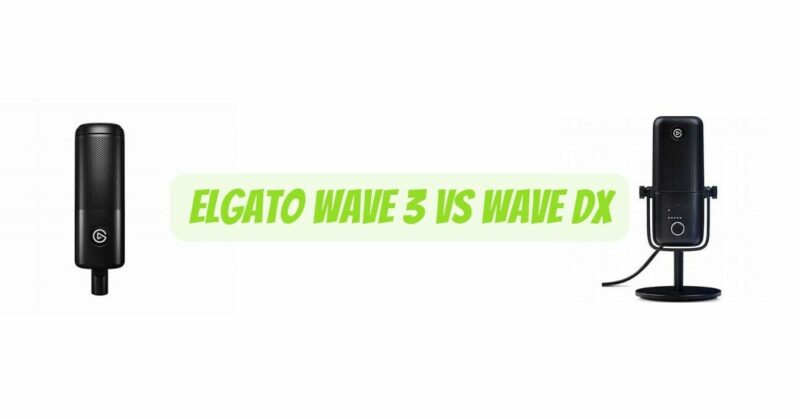Elgato has established itself as a reputable brand in the world of content creation, offering a range of high-quality USB microphones. In this article, we will compare two popular models, the Elgato Wave 3 and the Elgato Wave DX, to help you make an informed decision when choosing the right USB microphone for your needs. Both microphones come with advanced features and technologies, but they do have some notable differences. So, let’s dive into the details and explore the similarities and distinctions between the Elgato Wave 3 and Wave DX.
Design and Build Quality: Both the Elgato Wave 3 and Wave DX feature sleek and modern designs that are visually appealing. They are built with durable materials to ensure longevity and withstand regular use.
The Elgato Wave 3 showcases a compact and streamlined design. It features a sturdy metal construction with a removable magnetic desk stand, allowing you to place it on your desk or mount it on a boom arm. The front of the microphone houses capacitive touch controls for muting, volume adjustment, and headphone volume control, providing convenient access to essential functions.
On the other hand, the Elgato Wave DX takes a slightly different approach in design. It sports an elongated cylindrical shape and features a robust all-metal construction. The Wave DX includes a detachable magnetic desk stand and can be easily mounted on a boom arm. It offers physical buttons for muting and controlling the headphone volume, providing tactile feedback during operation.
Sound Quality: When it comes to sound quality, both the Elgato Wave 3 and Wave DX deliver exceptional audio performance, thanks to their high-quality condenser capsules and advanced audio processing technologies.
The Elgato Wave 3 features a 24-bit/96kHz sample rate, providing crisp and clear audio reproduction. It utilizes a cardioid polar pattern, which focuses on capturing sound from the front while minimizing background noise. The Wave 3 also incorporates a built-in pop filter and shock mount, reducing plosive sounds and handling noise for cleaner recordings.
In comparison, the Elgato Wave DX offers even more advanced sound processing capabilities. It features a dual-capsule design, allowing you to switch between a cardioid polar pattern and a stereo polar pattern. This versatility makes it suitable for a variety of recording scenarios, including podcasting, music production, and ASMR. The Wave DX also includes a built-in digital mixer with EQ and compression controls, enabling you to fine-tune your audio to perfection.
Software Integration and Features: Both the Elgato Wave 3 and Wave DX are compatible with the Elgato Wave Link software, which provides extensive control and customization options for your audio setup.
The Wave Link software allows you to adjust microphone gain, monitor mix, and other audio sources with ease. It also provides the flexibility to create independent virtual audio channels, perfect for managing multiple audio sources in real-time. The software is intuitive and user-friendly, offering a seamless integration with the Elgato Wave 3 and Wave DX microphones.
One notable distinction is that the Elgato Wave DX offers additional hardware integration with the Elgato Stream Deck. With the Stream Deck, you can assign specific actions, such as muting the microphone, changing audio sources, or activating effects, to customizable buttons. This integration enhances the convenience and efficiency of your content creation workflow.
Connectivity and Compatibility: Both the Elgato Wave 3 and Wave DX utilize USB-C connections, ensuring fast and reliable data transfer for low-latency audio.
The Elgato Wave 3 features a USB-C to USB-A cable, allowing it to be easily connected to a wide range of devices, including Windows and Mac computers, as well as gaming consoles like PlayStation and Xbox.
Similarly, the Elgato Wave DX also utilizes a USB-C connection, providing universal compatibility with USB-C enabled devices. It comes with both USB-C to USB-A and USB-C to USB-C cables, giving you the flexibility to connect to various devices without any hassle.
Price and Value: In terms of pricing, the Elgato Wave 3 is generally more budget-friendly compared to the Elgato Wave DX. However, it’s important to consider the specific features and functionality that each microphone offers and determine which aligns best with your needs and budget.
The Elgato Wave 3 offers a solid balance between affordability and advanced features, making it suitable for content creators looking for professional-grade audio performance without breaking the bank. On the other hand, the Elgato Wave DX caters to users who require even more advanced sound processing capabilities, making it ideal for those who prioritize versatility and precise control over their audio recordings.
Conclusion: Both the Elgato Wave 3 and Wave DX are excellent USB microphones that cater to the needs of content creators. While the Elgato Wave 3 offers a compact design, high-quality sound, and seamless integration with the Elgato Wave Link software, the Wave DX takes audio processing to the next level with its dual-capsule design, advanced mixer controls, and Stream Deck integration.
Ultimately, the choice between the Elgato Wave 3 and Wave DX depends on your specific requirements and budget. If you’re looking for a solid USB microphone with great sound quality and essential features, the Elgato Wave 3 is a reliable option. However, if you require more advanced audio processing capabilities and the convenience of hardware integration, the Elgato Wave DX is worth considering.
Whichever microphone you choose, both the Elgato Wave 3 and Wave DX will elevate your content creation with their impressive audio performance and user-friendly features.


